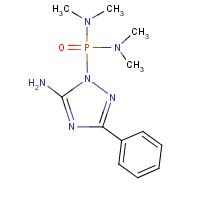Triamiphos
Agent Name
Triamiphos
CAS Number
1031-47-6
Formula
C12-H19-N6-O-P
Major Category
Pesticides

Synonyms
3-Phenyl-5-amino-1,2,4-triazolyl-(1)-(N,N'-tetramethyl) diamidophosphonate; 5-Amino-1-(bis(dimethylamino)phosphinyl)-3-phenyl-1,2,4-triazole; 5-Amino-1-bis(dimethylamide)phosphoryl-3-phenyl-1,2,4-triazole; 5-Amino-1-bis(dimethylamido)phosphoryl-3-phenyl-1,2,4-triazole; 5-Amino-3-fenil-1-bis(-dimetilamino)-fosforil-1,2,4-triazolo [Italian]; 5-Amino-3-fenyl-1-bis(dimethyl-amino)-fosforyl-1,2,4-triazool [Dutch]; 5-Amino-3-phenyl-1,2,4-triazole-1-yl-N,N,N',N'-tetramethylphosphodiamide; 5-Amino-3-phenyl-1,2,4-triazolylbis(dimethylamino)-phosphinoxid [German]; 5-Amino-3-phenyl-1-bis (dimethyl-amino)-phosphoryle-1,2,4-triazole [French]; 5-Amino-3-phenyl-1-bis(dimethylamino)-phosphoryl-1H-1,2,4-triazol [German]; Bis(dimethylamino)-3-amino-5-phenyltriazolyl phosphine oxide; ENT 27,223; Niagara 5943; P-(5-Amino-3-phenyl-1H-1,2,4-triazol-1-yl)-N,N,N',N'-tetramethyl-phosphonic diamide; Triamifos [German, Dutch, Italian]; Triamiphos [ISO:BSI]; Triamphos; WP 155; Wepsin; Wepsyn; Wepsyn 155; P-(5-Amino-3-phenyl-1H-1,2,4-triazol-1-yl)-N,N,N',N'-tetramethylphosphonic diamide; P-(5-Amino-3-phenyl-1H-1,2,4-triazol-1-yl)-N,N,N',N’-tetramethyl phosphonic diamide; Phosphonic diamide, P-(5-amino-3-phenyl-1H-1,2,4-triazol-1-yl)-N,N,N',N'-tetramethyl-; [ChemIDplus]
Category
Organophosphate Insecticides
Description
Colorless or white solid; [HSDB]
Sources/Uses
Used as fungicide to control powdery mildews; [HSDB] Used on apples and ornamentals; Discontinued by US manufacturer; [CAMEO]
Comments
Causes moderate to severe erythema and moderate edema to skin; [HSDB] A cholinesterase inhibitor; Can be absorbed through skin; [CAMEO] “The average of two baseline respective cholinesterase activity determinations three days apart, with no exposures to enzyme inhibiting pesticides for at least 30 days, is recommended for each worker prior to exposure to cholinesterase inhibitors because of large inter-individual differences in published baseline values. To be established at least once a year. Removal from workplace exposures is recommended until the cholinesterase activity returns to within 20% of baseline.” [TLVs and BEIs]
Biomedical References
Exposure Assessment
BEI
Acetylcholinesterase activity in red blood cells = 70% of individual's baseline; Butylcholinesterase activity in serum or plasma = 60% of individual's baseline; Sample at end of shift; [TLVs and BEIs]
Adverse Effects
Other Poison
Organophosphate
Diseases, Processes, and Activities Linked to This Agent
Diseases
Occupational diseases associated with exposure to this agent:
Processes
Industrial Processes with risk of exposure: